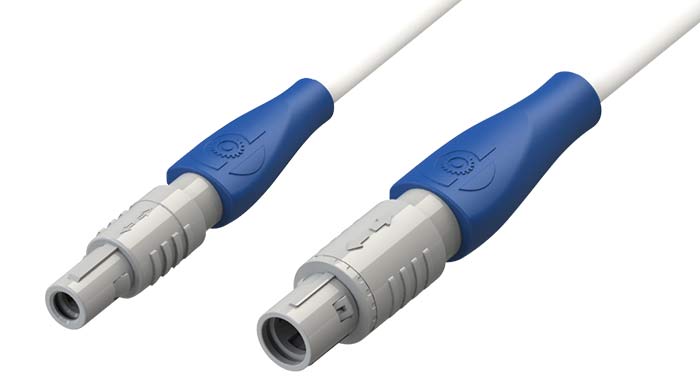Enabling Fast and Cost-Effective Creation of Medical-Grade Cables
Enabling Fast and Cost-Effective Creation of Medical-Grade Cables
Overview
As the medical devices industry continues to evolve, there is a growing need for new cabling technologies that can overcome the high-cost and long development cycles associated with traditional medical-grade cabling design approaches.
This article provides an overview of the conventional design challenges and details how new pre-configured, pre-tested, off-the-shelf, tooling-free cabling solutions can help save thousands of dollars and months of development time, while also reducing production cost and improving field usability.
This article provides an overview of the conventional design challenges and details how new pre-configured, pre-tested, off-the-shelf, tooling-free cabling solutions can help save thousands of dollars and months of development time, while also reducing production cost and improving field usability.

Figure 1 – Growing need for medical-grade cabling
Key Requirements in the Design of Medical-Grade Cabling
While cabling is typically not the primary focus in design of new medical devices, robust cable connections represent a critical factor for success, which all too often can become a gating factor in both development and deployment of new medical systems.
For example, development of new advanced surgical systems for operating rooms usually requires robust cabling solutions that can connect systems in the sterile operating room environment with other systems located either inside or outside of the operating room.
For example, development of new advanced surgical systems for operating rooms usually requires robust cabling solutions that can connect systems in the sterile operating room environment with other systems located either inside or outside of the operating room.
Or, in paramedic field environments, users may need to quickly connect systems together for emergency procedures. The rise of remote telemedicine applications also is requiring easy-to-connect cabling solutions that can be correctly connected in the field, often by untrained, non-medical users.
Some of the key requirements for medical-grade cabling include:
Some of the key requirements for medical-grade cabling include:
-
- Standardized-based connector pinout configurations
- Keyed interfaces to avoid mis-mating issues
- Built-in strain relief
- Quality conformance with IPC/WHMA-A-620 Class II standards
- Sealed for Ingress Protection against dust per IP50 standard

Figure 2 – Robust cabling solutions are needed for new advanced surgical systems
Challenges with Conventional Design Methodologies
The key drawbacks with traditional medical-grade cabling design revolve around time and money.
The typical process for full-custom cables has followed a sequence in which:
The typical process for full-custom cables has followed a sequence in which:
- The customer first provides specifications
- Vendors quote prices for the cables and associated tooling, as well as lead-times
- After ordering, the customer has to wait until delivery to determine the efficacy of the cable

Figure 3 – Save time and money with off-the-shelf medical cables
The problems with this process are:
- Delivery of a custom molded cable, even with a standard connector, can take 16 to 18 weeks.
- The cost of tooling required even for the first sample can be as much as $4,000 to $8,000.
- In addition, the customer likely needs to spend another $5,000 to $10,000 for testing the custom cable to assure adequate strain relief, bend relief, etc. in their application.
Leveraging a New Approach Using Pre-Configured Off-the-Shelf Solutions
Many medical device manufacturers are now turning to a new process, pioneered by Interplex, that focuses on rapid delivery of off-the-shelf, pre-configured and pre-tested medical grade cables, which can be delivered in three days and do not require any tooling costs.
The new Interplex Sureline series means that OEMs no longer have to engage with suppliers to create custom connector/cable assemblies for their latest equipment models. Instead, they can access to ready-to-use overmolded products that are far more cost-effective and convenient to implement.
The new Interplex Sureline series means that OEMs no longer have to engage with suppliers to create custom connector/cable assemblies for their latest equipment models. Instead, they can access to ready-to-use overmolded products that are far more cost-effective and convenient to implement.

Figure 4 – Interplex Sureline Plex 1 (left) and Plex 2 (right) are cost-efficient cable assemblies that meet IPC specifications
Available directly off-the-self, the Interplex Sureline medical-grade circular interconnect products are fully compatible with the widely used REDEL P1 and P2 connector format. They are available in 14-pole (Plex 1) 34-pole (Plex 2) versions.
Customers can stipulate to have the same connector on both ends of the cable or opt for a connector at one end and bare wires at the other. Depending on requirements, they can choose cable lengths of 3 feet (0.9m), 6 feet (1.8m) and 10 feet (3.05m). To assure robust performance, Interplex Sureline interconnects leverage the company’s patent pending SureFlex.
SureFlex is an overmold strain and bend relief with an ergonomic grip design that helps users properly align the connectors to avoid mis-mating of the connectors. This means that mating can be conducted quicker (which is advantageous in emergency situations), and the wear-and-tear that mis-mating attempts would otherwise cause is eliminated (thus extending operational lifespan).
Designed as a complete family of products, the Interplex Sureline series offers compatibility with leading connector formats, Plex 1 and Plex 2, with both male and female connectors, and options for a variety of cable lengths.
In addition, Interplex Sureline includes configurability within the core design, giving customers additional options for varying pin counts, keying positions, cable lengths, cable jacket, overmold color, and/or customization of overmold embossing.
Customers can stipulate to have the same connector on both ends of the cable or opt for a connector at one end and bare wires at the other. Depending on requirements, they can choose cable lengths of 3 feet (0.9m), 6 feet (1.8m) and 10 feet (3.05m). To assure robust performance, Interplex Sureline interconnects leverage the company’s patent pending SureFlex.
SureFlex is an overmold strain and bend relief with an ergonomic grip design that helps users properly align the connectors to avoid mis-mating of the connectors. This means that mating can be conducted quicker (which is advantageous in emergency situations), and the wear-and-tear that mis-mating attempts would otherwise cause is eliminated (thus extending operational lifespan).
Designed as a complete family of products, the Interplex Sureline series offers compatibility with leading connector formats, Plex 1 and Plex 2, with both male and female connectors, and options for a variety of cable lengths.
In addition, Interplex Sureline includes configurability within the core design, giving customers additional options for varying pin counts, keying positions, cable lengths, cable jacket, overmold color, and/or customization of overmold embossing.
Important benefits from the Interplex SureLine series include:
- Conforms to RoHS regulations.
- Designed and produced according to IPC/WHMA-A-620 Class II standards.
- SureFlex is resistant to mechanical stress from bending and pulling.
- Plex 1 and Plex 2 meet dielectric withstanding voltage (DMV) at 600V rms and 700V rms respectively.
- Insulation resistance (IR) at >12 TΩ.
- Meet IP50 sealing requirements.
Would you like to learn more about Interplex Sureline?
Summary
Interplex is a customized interconnect solution provider with technical expertise and vertically integrated manufacturing capabilities to resolve complex challenges for medical devices and other industries.
With introduction of the Interplex Sureline series, the innovation team at Interplex has once again disrupted the status quo, giving OEMs the ability to rapidly proof out their new designs without long delays, large upfront costs, and the risks of incompatibility.
Among the core applications that the Interplex Sureline interconnects are intended to address will be surgical equipment, medical imaging systems, diagnostic instrumentation, respiratory equipment, and patient monitoring units. Outside of healthcare, they can also be used in industrial testing and data logging systems. New cable lengths and pin configurations will be introduced over the course of 2023.
With introduction of the Interplex Sureline series, the innovation team at Interplex has once again disrupted the status quo, giving OEMs the ability to rapidly proof out their new designs without long delays, large upfront costs, and the risks of incompatibility.
Among the core applications that the Interplex Sureline interconnects are intended to address will be surgical equipment, medical imaging systems, diagnostic instrumentation, respiratory equipment, and patient monitoring units. Outside of healthcare, they can also be used in industrial testing and data logging systems. New cable lengths and pin configurations will be introduced over the course of 2023.
For More Information:
- Discover Interplex Sureline at MD&M West 2023. Register for the event here.




